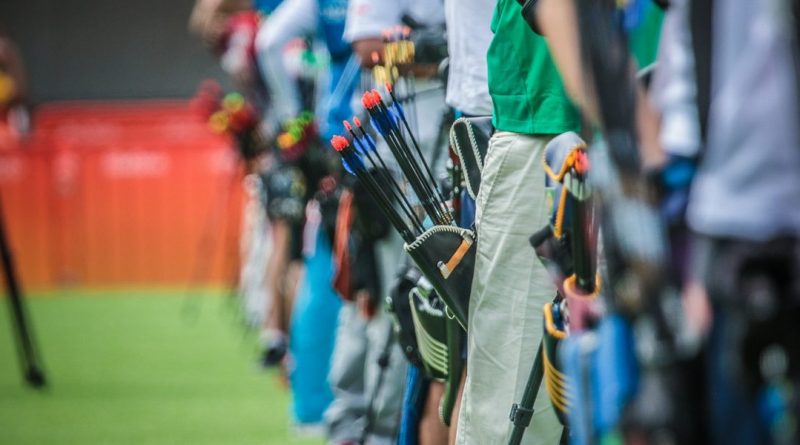Hip vs. Back: Choose the Right Quiver for You
Whether you bowhunt or shoot target archery, you want quick, easy access to your arrows. Cue the quiver, the accessory that holds your arrows. If you want a quiver that’s portable, detaches from your bow, and carries many arrows, a hip or back quiver might be the best fit.
But which quiver type should you choose? Like most wearable gear, quivers come in different looks and styles. The main difference between hip quivers and back quivers is that one hangs off your hip while the other hangs across your back. You must also choose between two types of hip quivers: target and field.
Hip Quivers:

Target quivers, however, offer more storage pockets and clips for accessories and tools. As with field quivers, target quivers hang off the hip with a clip or belt. They also have three to four built-in plastic tubes that separate your arrows. Photo Credit: World Archery
Target Quiver
The name says it all. Target archers who like hip quivers often go for target quivers, which lean the arrows’ fletching forward and their points down. That makes it much easier to see and sort through your arrows. If you shoot a variety of arrows or number them, target quivers are ideal. Grabbing arrows from target quivers requires just a quick reach to your side.
What’s their downside? Christine Harrelson of Christine Harrelson Archery is an archery pro and instructor. She notes that target quivers can sway and hit your side more so than field quivers as you walk at 3-D or field shoots. They also tend to stick out in front, which can be inconvenient during competitions.
“I’ve always felt this style quiver was more likely to interfere with a shooter standing in front of me,” Harrelson said.
Target quivers, however, offer more storage pockets and clips for accessories and tools. As with field quivers, target quivers hang off the hip with a clip or belt. They also have three to four built-in plastic tubes that separate your arrows. They’re usually made of leather or synthetic fabrics.

Grabbing an arrow from field quivers requires a short, simple motion similar to that used with target quivers. Instead of reaching in front of you, however, just reach behind. Photo Credit: World Archery
Field Quiver
If you enjoy field courses or 3-D ranges that snake through woods, consider using a field quiver, which is basically a target quiver that leans the fletching backward and the points down. In that position, arrows catch on branches less often.
Harrelson prefers her arrows to lean backward like those in a field quiver, but she customized her quiver to reduce the angle.
“I did this so the arrows wouldn’t hit the person behind me when standing on a very tight shooting line, as often happens at indoor tournaments,” Harrelson said.
Grabbing an arrow from field quivers requires a short, simple motion similar to that used with target quivers. Instead of reaching in front of you, however, just reach behind.
One downside of field quivers is that you can’t conveniently see which arrow you’re grabbing without looking behind you. You’ll need to count your arrows as you shoot or turn to identify numbered arrows.
Field quivers are the traditional hip quiver. Clip them to a belt loop or onto your belt. They’re also archery’s lightest quivers. They’re typically made of leather or synthetic fabrics, and they’re easy to pack in your bag or bow case. Many feature customizable arrow-management systems and a small pocket for extra gear.
Back Quiver:

Some field and 3-D archers prefer back quivers because they don’t get in the way while walking a course or navigating through the woods. They’re also versatile, accommodating right- or left-handed shooters. Photo credit: ATA
“Robin Hood” or “Hunger Games” movies always come to mind with back quivers. They’re the preferred arrow carriers of traditional archers, and sling diagonally across your back.
Some field and 3-D archers prefer back quivers because they don’t get in the way while walking a course or navigating through the woods. They’re also versatile, accommodating right- or left-handed shooters.
To pull an arrow from a back quiver, you must reach over your shoulder and feel for it. It takes a little practice, but you can reload quickly because your hand is already near the arrows after each shot.
And because archers must occasionally bend their knees to pick something up or look for something on the ground, they can dump their arrows accidentally.
“Archers quickly realize that bending over with a back quiver is a big no-no,” Harrelson.
You’ll also want to count your arrows as you shoot because you won’t be able to see how many arrows are left in your quiver.
Back quivers hold lots of arrows, but usually don’t have pockets or pouches for storage. They typically have a traditional design, and are made of leather or leather-like materials.
Although quivers are functional, Harrelson said they can also express style and personality. Your quiver choice is just a matter of preferences. Try all three types to help you decide which quiver is best for you.
The post Hip vs. Back: Choose the Right Quiver for You appeared first on Archery 360.
The article was originally seen at https://www.archery360.com/2018/05/22/hip-vs-back-choose-right-quiver/
Originally posted 2018-05-24 10:08:13.




